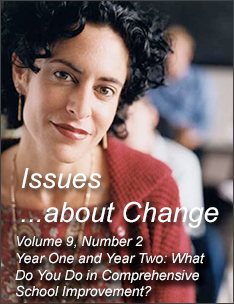Personal and Social Dynamics of Individuals and Organizations
Year 1.
SEDL facilitators observed the personal and social dynamics that impacted improvement efforts at each school, advanced dynamics that supported those efforts, and - most critically - avoided being drawn into or aligned with any one side of personal and social conflicts involving the partner schools.
At Banner and Community High Schools, personal and social dynamics were generally positive. Banner High School was marked by strong, clear, and widespread teacher commitment to and knowledge of students. For the most part, this commitment fueled supportive professional relationships between teachers, although there was little opportunity for teachers' suggestions to be incorporated into administrative decisions about the new academy structure. At Community High School, trust in the principal translated into the ability for teachers to work well with one another, and to ignore small factions that arose in opposition to improvement efforts.
In schools where the personal and social dynamics were less positive, SEDL facilitators sought to engage all staff in the improvement efforts - and in the meetings and decision-making that informed and shaped those efforts. Nudging teachers to learn one another's names by asking a group who is missing provided a small but vital foundation for teachers to begin talking to one another about instruction at Pelican High School. At San Fernando, providing the opportunity for staff to discuss the issues that simmered between them allowed some of these issues to be resolved. At Tall Pines, attending to organizational structures helped to dispel some of the tensions that precluded the development of strong personal relationships among teachers and staff.
Year 2.
For the most part, issues of personal and social dynamics were addressed only tangentially during the second year. SEDL staff maintained their focus on building relationships among teachers and between teachers and administrators in the context of professional development and school improvement efforts. When facilitating meetings, SEDL staff worked to ensure that every voice was heard, and maintained professional neutrality when tensions emerged. SEDL staff utilized emerging teacher leaders and other individuals invested in school change efforts to encourage schoolwide commitment to the project. In this project and in others, SEDL has learned that professional growth, focused efforts toward school improvement, and the academic success of students form the strongest bonds between school professionals.
Banner High School and Tall Pines Middle School did provide notable exceptions, where personal and social dynamics jeopardized improvement efforts. At Banner, three of the four academy principals began to isolate and undermine the fourth principal, and to reduce their commitment to the FIRST project. These three principals ultimately left the FIRST project, and the SEDL facilitator worked exclusively with that fourth principal, in the academy she administered.
Issues related to leadership negatively impacted personal and social dynamics at Tall Pines Middle School. A school climate survey was conducted during each year of the FIRST project - all indicators fell in the second year, and the subscale of "Collegial support" fell most dramatically. Unfortunately, SEDL could do little to directly address these issues until issues of leadership improved.
Reflection.
Personal and social dynamics is perhaps the least distinctly bounded of the five critical areas the FIRST project identified and addressed. Problems that are rooted in leadership, context, and organizational structures almost always affect personal and social dynamics negatively. Similarly, advancement in any of the four other areas tends to support positive dynamics. But, while SEDL facilitators acknowledged that personal and social dynamics tended to bleed into and out of the other critical areas, they found it remained an important area to consider independently.
When school personnel know and trust one another, the work of school change gets easier. Communicating expectations of respect and participation, bringing parties in conflict together to dialogue, and teaching techniques for assuring full participation and equal representation helped to advance positive personal and social dynamics, which in turn advanced school improvement efforts.
Next Page: Contextual Influences

